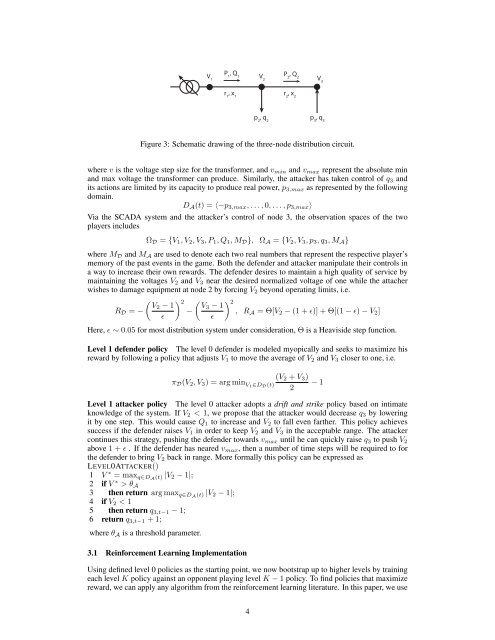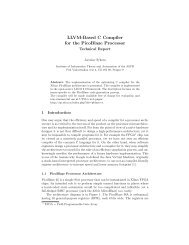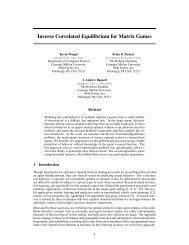VP 1, Q 1 1V P 2, Q 22V 3r 1, x 1r 2, x 2p 2, q 2p 3, q 3Figure 3: Schematic drawing <strong>of</strong> the three-node distribution circuit.where v is the voltage step size for the transformer, and v min and v max represent the absolute minand max voltage the transformer can produce. Similarly, the attacker has taken control <strong>of</strong> q 3 andits actions are limited by its capacity to produce real power, p 3,max as represented by the followingdomain.D A (t) = 〈−p 3,max , . . . , 0, . . . , p 3,max 〉Via the SCADA system and the attacker’s control <strong>of</strong> node 3, the observation spaces <strong>of</strong> the twoplayers includesΩ D = {V 1 , V 2 , V 3 , P 1 , Q 1 , M D }, Ω A = {V 2 , V 3 , p 3 , q 3 , M A }where M D and M A are used to denote each two real numbers that represent the respective player’smemory <strong>of</strong> the past events in the game. Both the defender and attacker manipulate their controls ina way to increase their own rewards. The defender desires to maintain a high quality <strong>of</strong> service bymaintaining the voltages V 2 and V 3 near the desired normalized voltage <strong>of</strong> one while the attacherwishes to damage equipment at node 2 by forcing V 2 beyond operating limits, i.e.( ) 2 ( ) 2 V2 − 1 V3 − 1R D = −−, R A = Θ[V 2 − (1 + ɛ)] + Θ[(1 − ɛ) − V 2 ]ɛɛHere, ɛ ∼ 0.05 for most distribution system under consideration, Θ is a Heaviside step function.Level 1 defender policy The level 0 defender is modeled myopically and seeks to maximize hisreward by following a policy that adjusts V 1 to move the average <strong>of</strong> V 2 and V 3 closer to one, i.e.(V 2 + V 3 )π D (V 2 , V 3 ) = arg min V1∈D D (t) − 12Level 1 attacker policy The level 0 attacker adopts a drift and strike policy based on intimateknowledge <strong>of</strong> the system. If V 2 < 1, we propose that the attacker would decrease q 3 by loweringit by one step. This would cause Q 1 to increase and V 2 to fall even farther. This policy achievessuccess if the defender raises V 1 in order to keep V 2 and V 3 in the acceptable range. The attackercontinues this strategy, pushing the defender towards v max until he can quickly raise q 3 to push V 2above 1 + ɛ . If the defender has neared v max , then a number <strong>of</strong> time steps will be required to forthe defender to bring V 2 back in range. More formally this policy can be expressed asLEVEL0ATTACKER()1 V ∗ = max q∈DA (t) |V 2 − 1|;2 if V ∗ > θ A3 then return arg max q∈DA (t) |V 2 − 1|;4 if V 2 < 15 then return q 3,t−1 − 1;6 return q 3,t−1 + 1;where θ A is a threshold parameter.3.1 Reinforcement Learning ImplementationUsing defined level 0 policies as the starting point, we now bootstrap up to higher levels by trainingeach level K policy against an opponent playing level K − 1 policy. To find policies that maximizereward, we can apply any algorithm from the reinforcement learning literature. In this paper, we use4
an ɛ-greedy policy parameterization (<strong>with</strong> ɛ = 0.1) and SARSA on-policy learning [8]. Trainingupdates are performed epoch-wise to improve stability. Since the players’ input spaces containcontinuous variables, we use a neural-network to approximate the Q-function [9]. We improveperformance by scheduling the exploration parameter ɛ in 3 segments during training: An ɛ <strong>of</strong> nearunity, followed by a linearly decreasing segment, then finally the desired ɛ.3.2 Results and DiscussionWe present results <strong>of</strong> the defender and attacker’s behavior at various level K. We note that ourscenario always had an attacker present, so the defender is trained to combat the attacker and has notraining concerning how to detect an attack or how to behave if no attacker is present. Notionally,this is also true for the attacker’s training. However in real-life the attacker will likely know thatthere is someone trying to thwart this attack.Level 0 defender vs. level 0 attacker The level 0 defender (see Figure 4(a)) tries to keep bothV 2 and V 3 close to 1.0 to maximize his immediate reward. Because the defender makes steps in V 1<strong>of</strong> 0.02, he does nothing for 30 < t < 60 because any such move would not increase his reward.For 30 < t < 60, the p 2 , q 2 noise causes V 2 to fluctuate, and the attacker seems to randomly driftback and forth in response. At t = 60, the noise plus the attacker and defender actions breaksthis “symmetry”, and the attacker increases his q 3 output causing V 2 and V 3 to rise. The defenderresponds by decreasing V 1 , indicated by the abrupt drops in V 2 and V 3 that break up the relativelysmooth upward ramp. Near t = 75, the accumulated drift <strong>of</strong> the level 0 attacker plus the response<strong>of</strong> the level 0 defender pushes the system to the edge. The attacker sees that a strike would besuccessful (i.e., post-strike V 2 < 1 − θ A ), and the level 0 defender policy fails badly. The resultingV 2 and V 3 are quite low, and the defender ramps V 1 back up to compensate. Post strike (t >75), the attackers threshold criterion tells him that an immediate second strike would would not besuccessful, however, this shortcoming will be resolved via level 1 reinforcement learning. Overall,this is the behavior we have built into the level 0 players.Level 1 defender vs. level 0 attacker During the level 1 training, the defender likely experiencesthe type <strong>of</strong> attack shown in Figure 4(a) and learns that keeping V 1 a step or two above 1.0 is a goodway to keep the attacker from putting the system into a vulnerable state. As seen in Figure 4(b), thedefender is never tricked into performing a sustained drift because the defender is willing to takea reduction to his reward by letting V 3 stay up near 1.05. For the most part, the level 1 defender’sreinforcement learning effectively counters the level 0 attacker drift-and-strike policy.Level 0 defender vs. level 1 attacker The level 1 attacker learning sessions correct a shortcomingin the level 0 attacker. After a strike (V 2 < 0.95 in Figure 4(a)), the level 0 attacker drifts up fromhis largest negative q 3 output. In Figure 4(c), the level 1 attacker anticipates that the increase in V 2when he moves from m = −5 to m = 5 will cause the level 0 defender to drop V 1 on the next move.After this drop, the level 1 attacker also drops from m = +5 to −5. In essence, the level 1 attackeris leveraging the anticipated moves <strong>of</strong> the level 0 defender to create oscillatory strikes that push V 2below 1 − ɛ nearly every cycle.AcknowledgmentsThis research was supported by the NASA Aviation Safety Program SSAT project, and the LosAlamos National Laboratory LDRD project Optimization and Control Theory for Smart Grid.References[1] Miguel Costa-Gomes and Vincent Crawford. Cognition and behavior in two-person guessing games: Anexperimental study. American Economic Review, 96(5):1737–1768, December 2006.[2] Dale O. Stahl and Paul W. Wilson. On players’ models <strong>of</strong> other players: Theory and experimental evidence.Games and Economic Behavior, 10(1):218 – 254, 1995.[3] Richard Mckelvey and Thomas Palfrey. Quantal response equilibria for extensive form games. ExperimentalEconomics, 1:9–41, 1998. 10.1023/A:1009905800005.5
- Page 1 and 2: The 2nd International Workshop onDE
- Page 3 and 4: The 2nd International Workshop onDE
- Page 5 and 6: Time Title Authors7:30—7:50 Openi
- Page 7 and 8: Modeling Humans as Reinforcement Le
- Page 9: solution concept used to predict th
- Page 13 and 14: Automated Explanations for MDP Poli
- Page 15 and 16: V E = ∑ i∈Eλ π∗s 0(sc i )
- Page 17 and 18: Figure 1: User Perception of MDP-Ba
- Page 19 and 20: [9] Warren B. Powell. Approximate D
- Page 21 and 22: information (technological knowledg
- Page 23 and 24: The complete fulfilment of preferen
- Page 25 and 26: References[1] J.O. Berger. Statisti
- Page 27 and 28: (happiness, anger, fear, disgust, s
- Page 30 and 31: David H Wolpert, editors, Decision
- Page 32 and 33: on some of their concepts, we devel
- Page 34 and 35: We assume that they are evaluated t
- Page 36 and 37: AcknowledgmentsResearch supported b
- Page 38 and 39: Bayesian Combination of Multiple, I
- Page 40 and 41: is not in closed form [5], requirin
- Page 42 and 43: where α (k)j is updated by adding
- Page 44 and 45: Figure 3: Prototypical confusion ma
- Page 46 and 47: Artificial Intelligence Designfor R
- Page 48 and 49: the game. Each has its own attribut
- Page 50 and 51: 4.3 Experimental Results and Limita
- Page 52 and 53: Distributed Decision Making byCateg
- Page 54 and 55: q 1a 1 (1) b 1(1)a 2(1)b 2(1)a K(1)
- Page 56 and 57: Bayes risk0.250.20.150.10.05Collabo
- Page 58 and 59: Decision making and working memory
- Page 60 and 61:
in WM as well as inhibitory tasks [
- Page 62 and 63:
Difficulty level will be automatica
- Page 64 and 65:
Overall, the current literature lea
- Page 66 and 67:
[31] W K Bickel, R Yi, R D Landes,
- Page 68 and 69:
Each time instant, the agents first
- Page 70 and 71:
Figure 2: Two basic decentralized a
- Page 72 and 73:
[11] M. Kárný and T.V. Guy. Shari
- Page 74 and 75:
these results yields a design metho
- Page 76 and 77:
Minimum of (16) is well known from
- Page 78 and 79:
Algorithm 2 VB-DP variant of the di
- Page 80 and 81:
Further simplications can be achiev
- Page 82 and 83:
The basic terms we use are as follo
- Page 84 and 85:
3 Connection to the Bayesian soluti
- Page 86 and 87:
4 ConclusionThis paper brings an im
- Page 88 and 89:
2 Dynamic programming and revisions
- Page 90 and 91:
The possible way how to recognize t
- Page 92 and 93:
The data used for experiment are da
- Page 95:
T.V. Guy, Institute of Information







